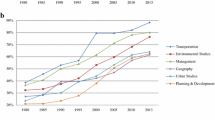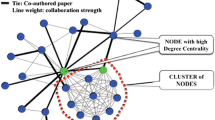Abstract
This study examines the relationship between citation frequency and the human capital of teams of authors. Analysis of a random sample of articles published in top natural science journals shows that articles co-authored by teams including frequently cited scholars and teams whose members have diverse disciplinary backgrounds have greater citation frequency. The institutional prestige, the percentage of team members at U. S. institutions and the variety of disciplines represented by team member backgrounds do not influence citation frequency. The study introduces a method for evaluating the extent of multidisciplinarity that accounts for the relatedness of disciplines or authors.
Similar content being viewed by others
References
Acedo, F. J., Barroso, C., Casanueva, C., Galan, J. L. (2006), Co-authorship in management and organization studies. Journal of Management Studies, 5: 957–983.
Adams, J. D., Black, G. C., Clemons, J. R., Stephan, P. E., (2005), Scientific teams and institutional collaborations: Evidence from U. S. universities, 1981–1999. Research Policy, 34: 259–285.
Baldi, S. (1998), Normative versus social constructivist processes in the allocation of citations: A network-analytic approach. American Sociological Review, 63: 829–847.
Baron, R. M., Kenny, D. A. (1986), The moderator-mediator distinction in social psychological research: Conceptual, strategic and statistical considerations. Journal of Personality and Social Psychology, 6: 1173–1182.
Bimholtz, J. P. (2006), What does it mean to be an author? The intersection of credit, contribution and collaboration in science. Journal of the American Society for Information Science and Technology, 57: 1758–1770.
Braun, T., Schubert, A. (2007), The growth of research on inter-and multidisciplinarity in science and social science papers, 1975–2006. Scientometrics, 73: 345–351.
Cole, J. R., Cole, S. (1973), Social Stratification in Science. Chicago: University of Chicago Press.
Conlon, D., Morgenson, F., Mcnamara, G., Wiseman, R. M., Skilton, P. F. (2006), Examining the citation frequency and role of special issue and regular journal articles in the field of management. Academy of Management Journal, 49: 857–872.
Cronin, B. (1984), The Citation Process: The Role and Significance of Citations in Scientific Communication. London, Taylor Graham.
Cronin, B. (2005), The Hand of Science: Academic Writing and its Rewards. Scarecrow Press; Lanham, Maryland.
Cronin, B., Meho, L. (2006), Using the h-index to rank influential information scientists. Journal of the American Society for Information Science and Technology, 57: 1275–1278.
Dougherty, D. (1992), Interpretive barriers to successful product development in large firms. Organization Science, 3: 179–202.
Florian, R. V. (2007), Irreproducibility of the results of the Shanghai academic ranking of world universities. Scientometrics, 72: 25–32.
Gould, R. V. (2003), The origin of status hierarchies: A formal theory and empirical test. American Journal of Sociology, 107: 1143–1178.
Heinze, T., Bauer, G. (2007), Characterizing creative scientists in nano-S&T: Productivity, multidisciplinarity, and network brokerage in a longitudinal perspective. Scientometrics, 70: 811–830.
Hirsch, J. E. (2005), An index to quantify an individual’s scientific research output. Proceedings of the National Academy of Sciences of the United States of Americ, 102: 16569–16572.
Jaffe, A. B. (1986), Technological opportunity and spillovers from R&D: Evidence from firms’ patents, profits and market value. American Economic Review, 76: 984–1001
Katz, J. S., Martin, B. (1997), What is scientific collaboration? Research Policy, 26: 1–18.
Knorr-cetina, K. (1999), Epistemic Cultures: How the Sciences Make Knowledge. Cambridge, MA: Harvard University Press.
Latour, B. (1987), Science in Action. Cambridge, Harvard University press.
Leonard, D. A., Swap, W. C. (1999), When Sparks Fly: Igniting Creativity in Groups. Boston: Harvard Business School Press.
Li, S. X., Greenwood, R. (2004), The effect of within-industry diversification on firm performance: Synergy creation, multimarket contact and market structuration. Strategic Management Journal, 25: 1131–1153.
Merton, R. K. (1957), Social Theory and Social Structure. Glencoe, IL: The Free Press.
Merton, R. K. (1968), The Matthew effect in science: The reward and communication systems of science are considered. Science, 159: 56–63.
Nahapiet, J., Ghoshal, S. (1998), Social capital, intellectual capital and the organizational advantage. Academy of Management Review, 23: 242–266.
Oromaner, M. (1977), Professional age and reception of sociological publications-Test of Zuckerman-Merton hypothesis. Social Studies of Science, 7: 381–388.
Pasterkamp, G., Rotmans, J. I., De Kleijn, D. V. P., Borst, C. (2007), Citation frequency: A biased measure of research citation frequency significantly influenced by the geographical origin of research articles. Scientometrics, 70: 153–165.
Peters, H. F. P., van Raan, A. J. (1994), On determinants of citation scores: A case study in chemical engineering. Journal of the American Society for Information Science, 45: 39–50.
Podolny, J. M. (2005), Status Signals: A Sociological Study of Market Competition. Princeton: Princeton University Press.
Porac, J. F., Wade, J. B., Fischer H. M., Brown, J., Kanfer, A., Bowker, G. (2004), Human capital heterogeneity, collaborative relationships and publication patterns in a multidisciplinary scientific alliance: A comparative case study of two scientific teams. Research Policy, 33: 661–678.
Porter, A. L., Cohen, A. S., Roessner, J. D., Perrault, M. (2007), Measuring researcher interdisciplinarity. Scientometrics, 72: 117–147.
Schummer, J. (2005), Multidisciplinarity, interdisciplinarity, and patterns of research collaboration in nanoscience and nanotechnology. Scientometrics, 59: 425–465.
Science watch, (2005), Hottest journals of the millennium, so far. Citing URL: http://www.sciencewatch.com/jan-feb2005/sw_jan-feb2005_page1.htm
Shadish, W. R., Tolliver, D., Gray, M., SEN GUPTA, S. K. (1995), Author judgements about works they cite: Three studies from psychology journals. Social Studies of Science, 25: 477–498.
Sine, W. D., Shane, S., Di Gregorio, D. (2003), The Halo effect and technology licensing: The influence of institutional prestige on the licensing of university inventions. Management Science, 49: 478–496.
Skilton P. F. (2006), A comparative study of communal practice: Assessing the effects of taken-for-grantedness on citation practice in scientific communities. Scientometrics, 68: 73–96.
Small, H. (2004), On the shoulders of Robert Merton: Towards a normative theory of citation. Scientometrics, 60 (1): 71-79.
Sohn, M-W. (2001), Distance and cosine measures of niche overlap. Social Networks, 23: 141–165.
Thomson ISI Web of science, http://www.isinet.com/products/citation/wos
Van Dalen, H. P., Henken, K. (2007), Signals in science: On the importance of signaling in gaining attention in science. Scientometrics, 64: 209–233.
Vinkler, P. (1998), Comparative investigation of frequency and strength of motives toward referencing: The reference threshold model. Scientometrics, 43: 107–127.
Younglove-Webb, J., Gray, B., Abdalla, C. W., Thurow, A. P. (1999), The dynamics of multidisciplinary research teams in academia. The Review of Higher Education, 22: 425–440.
Author information
Authors and Affiliations
Corresponding author
Rights and permissions
About this article
Cite this article
Skilton, P.F. Does the human capital of teams of natural science authors predict citation frequency?. Scientometrics 78, 525–542 (2009). https://doi.org/10.1007/s11192-007-1953-z
Received:
Published:
Issue Date:
DOI: https://doi.org/10.1007/s11192-007-1953-z




